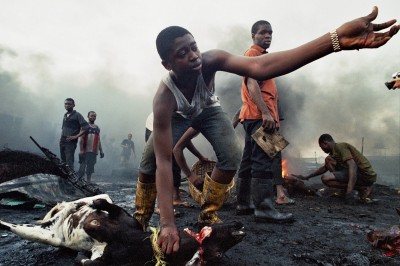
I’m looking forward to seeing Whore’s Glory, the third film in Michael Glawogger’s, Globalization Trilogy, with a mix of anticipation and dread.
The Austrian director’s trilogy spans the globe to give an intimate look at the life and work of people on the economic margins. The results are not always easy to watch.
Glawogger’s website calls Whore’s glory “a cinematic triptych on prostitution: three countries, three languages, three religions.” The film takes us from the massage parlor culture of Bangkok to a prison-like complex of brothels in Bangladesh and ends in Reynosa, a Mexican border town where prostitution and drug use is rampant.
If the first two films, Megacities and Workingman’s Death, are any indication of what’s to come in Whore’s Glory, I expect it will be something like being fed cake while being punched in the guts.
The two films contain a wrenching combination of beauty of despair. Both are packed to the rafters with rich and compelling images of people striving, suffering, and confronting death on a daily basis. Watching them, I was simultaneously fascinated and disturbed, titillated and confused. I can only begin to imagine the imagery that awaits in a Glawogger film focused on sex work.

Glawogger will be at the NW Film Forum this week as they screen the first two films and debut Whore’s Glory (full schedule below).
Here’s what to expect from the first two:
Megacities (1998), cuts back and forth between Mumbai, Mexico City, New York City and Moscow to tell “12 Stories of Survival”. The second film, Workingman’s Death (2005) gives us “5 portraits of Work in the 21st Century” from Ukraine, Indonesia, Nigeria, Pakistan and China.
These are purely observational films, with no explanatory narration. As Glawogger’s camera follows them, the words of the characters on screen provide the only context for what’s going on. This can create some interesting confusion when you watch one of the films without subtitles (as I did by accident).
I assumed this was a specific artistic choice of the director, putting the viewer off-kilter by plunging them completely into the world of the subject. I was initially sucked in by the imagery and my curiosity kept me watching, but as the film went on I got annoyed and then angry. Without any information about what I was seeing, it seemed like characters were being exploited. They weren’t given the chance to speak for themselves and explain their intentions and motivations.
I found myself muttering: “What the hell are they doing?” Things were happening on screen that were completely unintelligible to me. In one of the scenes from Moscow, middle-aged man after middle-aged man stripped down to their underwear and was locked into a room by ambiguously uniformed men. WHY?

I’ve since re-watched Megacities with subtitles, and some of those questions were answered (Re: the near naked men mentioned above, it was a drunk-tank). But the larger questions about the director’s intent remain. And they apply to Workingman’s Death as well. Glawogger’s willingness to let these questions linger are part of what make his films so effective.
Megacities and Workingman’s Death offer two levels of enjoyment. The raw images he captures are alluring and highly entertaining on their own, and the characters’ stories are engrossing but mysterious.
Seeing the films this week at Film Forum, with the director in attendance, offers you the unique opportunity to make your own judgments about Glawogger’s intentions and to what degree he is trying to torture his audience.
Megacities plays Tuesday at 8pm with the director in attendance.
Workingman’s Death plays Wednesday at 8pm with the director in attendance.
Whore’s Glory plays from April 27 through May 3.
1 Comment
Comments are closed.
1 Comment
-
Your take on this reminds me of Sontag’s article “Regarding the Torture of Others” (from back right after Abu Ghraib) re: visual records, memory and the problematic (but important) act of being a passive witness to suffering.
http://www.nytimes.com/2004/05/23/magazine/regarding-the-torture-of-others.html
Comments are closed.


Your take on this reminds me of Sontag’s article “Regarding the Torture of Others” (from back right after Abu Ghraib) re: visual records, memory and the problematic (but important) act of being a passive witness to suffering.
http://www.nytimes.com/2004/05/23/magazine/regarding-the-torture-of-others.html